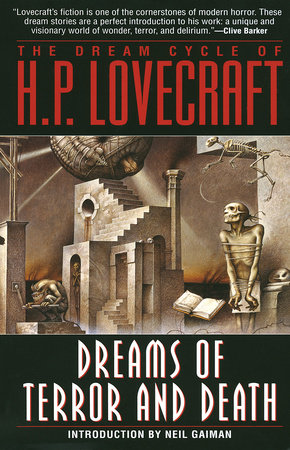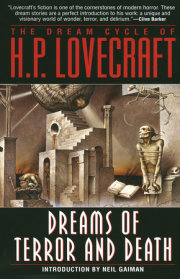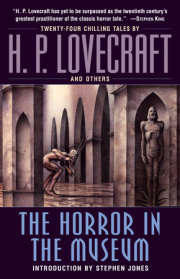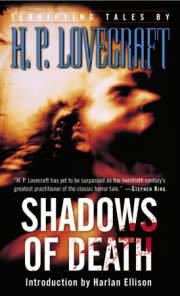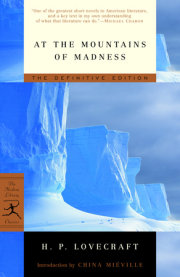Concerning Dreams and Nightmares
If Literature is the world, then Fantasy and Horror are twin cities, divided by a river of black water. Horror is a rather more dangerous place, or it should be: you can walk around Fantasy alone.
And if Horror and Fantasy are cities, then H. P. Lovecraft is the kind of long street that runs from the outskirts of the first city to the end of the other. It began as a minor thoroughfare, and is now a six-lane highway, built up on every side.
That’s H. P. Lovecraft the phenomenon. H. P. Lovecraft the man died at the age of forty-seven, over fifty years ago…
The man: thin, ascetic, an anachronism in his own time.
There’s a World Fantasy Award on the stairs; I pat its head as I walk past. A Gahan Wilson sculpture of Howard Phillips Lovecraft (1890–1937), it’s a portrait of a thin-lipped man, with a high forehead, a long chin, and wide eyes. He looks vaguely uncomfortable, vaguely alien, an Easter Island statue of a man.
He was a solitary individual, an inhabitant of Providence, Rhode Island. He communicated with the outside world through letters, some of them the length of short novels.
He wrote for the pulps: disposable fiction for publications like Weird Tales, its covers often showing vaguely arty lesbian bondage scenes. He ghostwrote a Houdini story, rewrote the work of aspiring writers; he sold both— At the Mountains of Madness and The Shadows of Time— to F. Orlin Tremaine’s Astounding Stories.
He was a believer in unpleasant doctrines of racial superiority, and was an Anglophile. He was a student of horror. There is an abundance of conjectures as to the circumstances of his life and death, of the roots of his fiction, but they remain theories.
In his lifetime, he wasn’t a major writer. He wasn’t even a minor writer. He was a minor pulp writer, as forgettable as any of his time. (Quick! Can you name five other writers for Weird Tales in the twenties and thirties?) But there was something there which, like Lovecraft’s own Cthulhu, did not die.
(Poor Robert E. Howard, creator of Conan and of King Kull, is one of the other Weird Tales authors who’s still remembered, when Seabury Quinn and many of the rest of them have blown away into the footnotes. Howard killed himself at the age of thirty, in 1936, when he heard of his mother’s impending death. Then there’s Robert Bloch, who, at the age of 18, published his first professional short story in Weird Tales, and went on to a long and distinguished career.)
Some of the influence of Lovecraft was immediate. His correspondents and fellow writers, including Bloch, Fritz Leiber, Manly Wade Wellman, and others, played with the mythos he created: a world in which we exist in a tiny fragment of space-time, in which space, inner and outer, is vast, and is inhabited by things that mean us harm, and by other things to which we matter less than cosmic dust. Much of Lovecraft’s influence on fiction, however, would not really be felt until fifty years after his death.
His fiction was not collected while he lived. August Derleth, Wisconsin author, cofounded (with Donald Wandrei) the small press Arkham House, in order to publish Lovecraft’s fiction, and Derleth first collected Lovecraft’s prose in The Outsider and Others, two years after Lovecraft’s death. Since then Lovecraft’s stories have been collected and re-collected internationally, in many anthologies, in many permutations.
This anthology is about dreams.
Dreams are strange things, dangerous and odd.
Last night I dreamed I was on the run from the government, somewhere in middle Europe— the last holdout of a decayed communist regime. I was kidnapped by the secret police, thrown in the back of a van. I knew that the secret police were vampires, and that they were scared of cats (for all vampires were scared of cats, in my dream). And I remember escaping from the van at a traffic light, running through the city, trying to call several unresponsive city cats to me: grey and sleek and skittish, they were unaware that they could save my life…
It is possible to go mad, looking for symbolism in dreams, looking for one-to-one correspondences with life. But the cats are Lovecraft’s. And the vampiric secret police, in their own way, are his, too.
Lovecraft got better as he went on.
That’s a polite way of putting it.
He was pretty dreadful when he started out: he seemed to have no ear for the music of words, no real sense of what he was trying to do with stories. There’s no feeling in the earliest material of someone putting their life, or even the inside of their head, down on paper; instead, we watch Lovecraft in the beginning, copying, pastiching awkwardly— here’s a dash of Poe, there’s a little Robert W. Chambers— and over and above all the other voices of Lovecraft’s early days, the awkward Anglophilic imitation of the voice of Lord Dunsany, the Irish lord and fantasist, whom Lovecraft admired more, perhaps, than was good for his fiction.
Dunsany was one of the great originals. His prose voice resonated like an oriental retelling of the King James Bible. He told stories of strange little gods of faraway lands, of visits to dreamlands, of people with odd but perfectly apt names; always with a slight amused detachment. Many of the stories you’ll find in this anthology, like “Hypnos,” or “The Quest of Iranon,” are vaguely Dunsanyish in tone.
Somewhere in there, however, as time passes, Lovecraft’s voice begins to emerge. The writing becomes assured. The landscape slowly becomes the inside of Lovecraft’s head.
It was September 1983, at the New Imperial Hotel in Birmingham, in the English Midlands: I had come to Birmingham for the British Fantasy Convention, to interview Gene Wolfe and Robert Silverberg for English magazines.
It was my first convention of any kind. I went to as many panels as I could, although I remember only one panel. The panelists were, if memory serves, authors Brian Lumley, Ramsey Campbell, the late Karl Edward Wagner, and Irish illustrator Dave Carson.
They talked about the influence of Lovecraft on each of them: Campbell’s hallucinatory tales of urban menace, Lumley’s muscular horror, Wagner’s dark sword and sorcery and modern, slick tales; they talked about the psychology of Lovecraft, the nightmarish visions, how each of them had found something in Lovecraft to which he responded, something that had inspired him: three very different authors, with three very different approaches.
A thin, elderly gentleman in the audience stood up and asked the panel whether they had given much thought to his own theory: that the Great Old Ones, the many-consonanted Lovecraftian beasties, had simply used poor Howard Phillips Lovecraft to talk to the world, to foster belief in themselves, prior to their ultimate return.
I don’t remember what the panel’s response was to that. I don’t recall them agreeing with it, though.
Then they were asked why they liked Lovecraft. They talked of the huge vistas of his imagination, of the way his fiction was a metaphor for everything we didn’t know and feared, from sex to foreigners. They talked about all that deep stuff.
Then Dave Carson, the artist, was handed the mike. “F——— all that,” he said happily, having drunk a great deal of alcohol, dismissing all the erudite psychological theories about Lovecraft and cutting to the chase. “I love H. P. Lovecraft because I just like drawing monsters.”
Which got a laugh from the audience, and a bigger laugh when Dave’s head gently touched down on the table a few seconds later, and then Karl Edward Wagner took the microphone from Dave’s fingers, and asked for the next question. (And now, a decade later, Dave Carson’s still with us, last heard of fishing off the pier at Eastbourne, probably fishing up the strange Lovecraftian beasties he draws so well from the depths of the English Channel so he can use them for reference, but the bottle carried away poor Karl.)
It’s true, though. Lovecraft’s influenced people as diverse as Stephen King and Colin Wilson, Umberto Eco and John Carpenter. He’s all over the cultural landscape: references to Lovecraft, and Lovecraftian ideas, abound in film, television, comics, role playing games, computer games, virtual reality…
Lovecraft is a resonating wave. He’s rock and roll.
I’m introducing a collection here that takes us though the dream fiction of H. P. Lovecraft, weaving it into a huge tapestry that drives from Fantasy to Horror and back again. Here’s the tale of “Pickman’s Model”— pure horror, and vintage Lovecraft— and then there’s Richard Upton Pickman, creeping through “The Dream Quest of Unknown Kadath”…The arrangement of stories forms odd patterns. Dreams and nightmares, too. Vampires and cats.
There’s something about Lovecraft’s fiction, about his worlds, that is oddly alluring for a writer of fantasy and horror. I’ve written three Lovecraftian stories: one obliquely, in Sandman—a quiet, dreamlike story (it’s the first story in the World’s End collection. You can tell it’s Lovecraftian, because I use the word “cyclopian” in it); one a hard-boiled Maltese Falcon variation with a werewolf as hero (in Stephen Jones’s fine anthology Shadows Over Innsmouth); and a third, when I was much younger, that was an awkward attempt at humor, an extract from Cthulhu’s autobiography. If I go back to Lovecraft again (and I’m sure I shall, before I die) it will probably be for something else entirely.
So what is it about Lovecraft that keeps me coming back? That keeps any of us coming back? I don’t know. Maybe it’s just that we like the way he gives us monsters to draw with our minds.
If this is your first excursion into H. P. Lovecraft’s world, you may find the way a little bumpy at first. But keep going.
You’ll soon find yourself driving down a road that will take you through the Twin Cities, and off into the darkness beyond.
If Literature’s the world.
And it is.
NEIL GAIMAN
APRIL 1995
Neil Gaiman is mentioned only once in the Lovecraft canon; the mysterious Dr. Charriere, in the Lovecraft-Derleth collaboration “The Survivor,” we are told, has a portrait of Gaiman on his wall, along with certain cabalistic charts, and pictures of large reptiles. Gaiman won the 1995 International Horror Critics’ Guild Award for best collection for his book Angels and Visitations, and has won pretty much every award, American and international, that it’s possible to get for writing comics, and one award that it’s impossible to get for writing comics any more, the aforementioned World Fantasy Award, for best short story (for Sandman #19)
Copyright © 2003 by H. P. Lovecraft. All rights reserved. No part of this excerpt may be reproduced or reprinted without permission in writing from the publisher.

